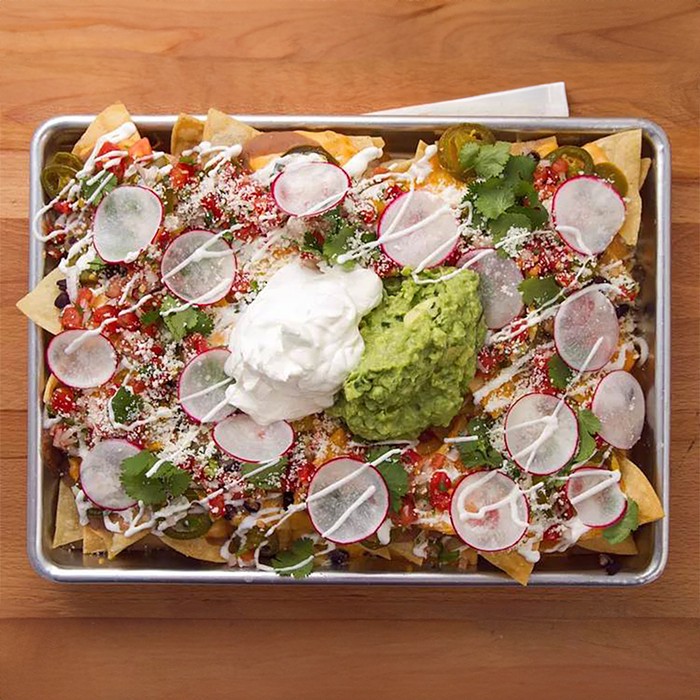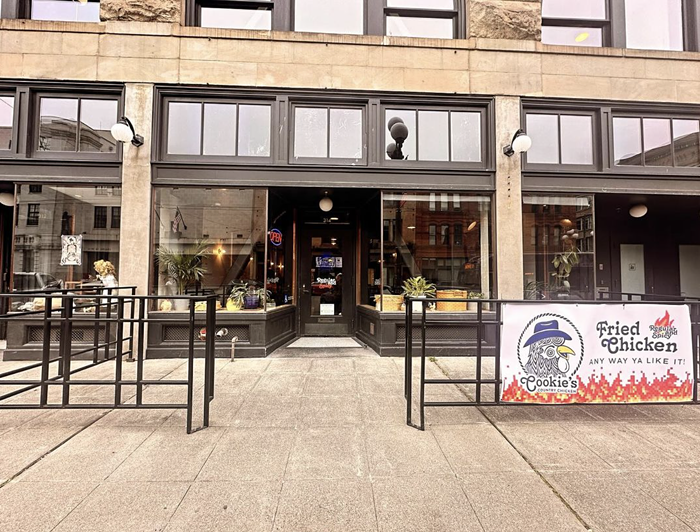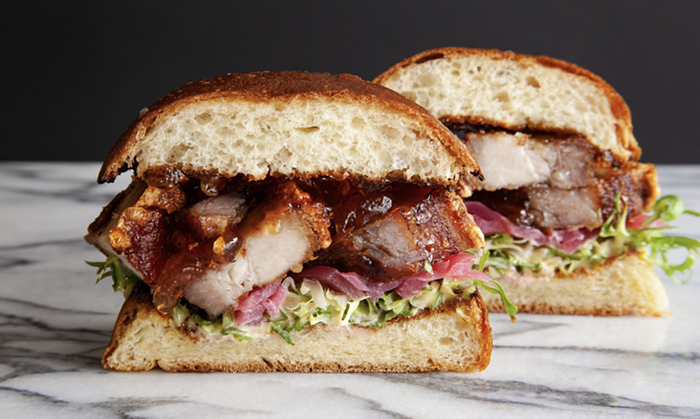This is not a review of Tavern Law. Tavern Law opened less than a month ago. It is barely a place at all, and it wouldn't be fair, according to convention, to review it at this juncture. I have eaten only three things at Tavern Law (a summer squash/Parmesan/basil risotto, which tasted lemony and was very fine; fried oysters, which could've used another moment of communion with hot oil to achieve optimal goldenness, but were good with their horseradish aioli and irrefutably delicious end-of-summer beefsteak tomato; and a small dish of some-are-hot-some-are-not grilled padrón peppers, of which I got a hot one, which was really, truly hot). I've had only two drinks: an Old Cuban, credited to Audrey Saunders of Pegu Club in New York, containing "Rum. Lime. Sugar. Angostura bitters. Mint. Champagne. $10," which was much more lively and refreshing than you might imagine an old Cuban to be; and a Morning Glory Fizz, Modern American Drinks, 1895, "Scotch. Lemon juice. Sugar. Absinthe. Egg white. Soda. $8," which, given all the strong flavors involved, turned out curiously (and perhaps fortuitously) neutral.
But while Tavern Law is barely a place, its place-ness is its most salient feature. It is such a place that it's nearly an abstraction; it's a place entirely based on other places, which are based (largely inaccurately) on yet other places, from yet another time. Tavern Law is distilled. Tavern Law is fiction. Tavern Law is theater. Tavern Law is trend incarnate.
Tavern Law is not a speakeasy, because a speakeasy does not have a liquor license; the two are mutually exclusive. And while Tavern Law, like the rash of other bars around the country (and here, e.g., Knee High Stocking Co. and Bathtub Gin & Co.) like it, aspires to be a speakeasy, even within this artifice is more artifice. As a June article ("Bar? What Bar?") in the New York Times by William Grimes pointed out, speakeasies were, more often than not, filthy dives serving terrible rotgut that sometimes killed the customers. (Cocktails of this era arose from desperation, to make the undrinkable into the chokable-down.) Tavern Law is mentioned in this article as not yet open, but about to join the crowd (including a bar called the Raines Law Room in New York; both Laws are references to actual old-timey liquor laws). Among Grimes's trenchant observations:
Obtrusively furtive, they represent one of the strangest exercises in nostalgia ever to grip the public, an infatuation with the good old days of Prohibition... In an age when virtually nothing is hidden or forbidden, the idea of a secret hideaway takes on an undeniable allure... Make it illegal, and they will come. If the authorities will not oblige, make it feel illegal. Nothing quite hits the spot like a martini in a ceramic mug.
At Tavern Law, the high-concept quote-speakeasy-unquote cocktail-culture fad has been taken to a mighty extreme: dapper barkeeps outfitted in suit vests and ties, many complicated and/or historic cocktails with house-made thises and thatses, effortful menu verbiage about the Volstead prohibition act and "the spirits of the night dancing on our tongues and in our hearts," specially made and especially slow-melting ice cubes, faux old-library decor, access granted to a "secret" door taken from an old safe by speaking into a telephone, a stairwell with sepia vintage nudie photos climbing the walls, a "secret" grandma's-whorehouse-den-of-iniquity-old-fashionedy lounge. (There's a "secret" bar—PDT, or Please Don't Tell—likewise accessed via a telephone-and-door setup in a phone booth in the back of a hot-dog place in the East Village.)
Tavern Law's owners are the gentlemen of Belltown's well-reputed, extremely popular Spur Gastropub, an upscale food-and-cocktail temple without such a vigorous theme. While the money they poured into Tavern Law is palpable, the production values vary. Downstairs, some knickknacks seem like a joke: duck decoys, collections on shelves that seem hastily assembled instead of covetously—how to put this—collected. When you look up, the illusion is entirely shattered; it is exactly a stage set, the room (the urge to use quotation marks is almost irresistible) imposed in the bottom of the space, then vents and pipes and lights high up above. The upstairs lounge more closely approximates authenticity, perhaps because of the odd-shaped layout, the ostentatious furnishings, the embrace of a low ceiling. Throughout, the only people with the correct costumes are the employees, which creates a reverberating dissonance: The patrons look ridiculous, whether they're in T-shirts or what passes for modern finery, while the workers look qualitatively better but still like actors in a period-piece murder-mystery dinner show. Above it all: the condominiums of the newly renovated 1919 Trace Lofts building, the dwellers-in of which were to have their own private entrance before fire code intervened. Tavern Law is still an amenity. One of the employees said that late on the night Tavern Law opened, a cocktail-replete Trace resident ceased being upright in the Trace Lofts lobby and remained that way for a rest. Tavern Law is end-stage capitalism.
Tavern Law has a roulette wheel on the wall behind the bar. It is nonoperational, being mounted at a jaunty, high-visibility angle such that a marble spun on it would be ejected into space. Once upon a time there was real gambling on Capitol Hill at a real speakeasy. It was one block away from where Tavern Law is now; when the heat was applied, it moved a few blocks another direction; when that building was torn down, it moved back. Everyone dressed up, in tuxedos or gowns or in louche, old-fashionedy, semi-punk ways. There was a password. There were careless drinks. There was money on green felt tables. There were lit cigarettes and guns and drugs. This past June, eight days after the New York Times article, there were cops and a bust and handcuffs for the man who ran the speakeasy, Rick Wilson, who is now awaiting trial. By all accounts, the real speakeasy was really, truly fun. ![]()



















